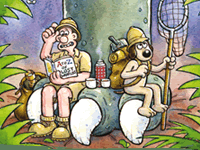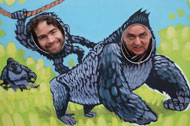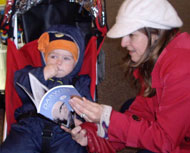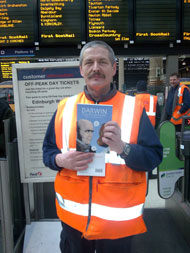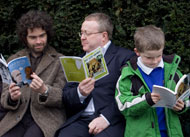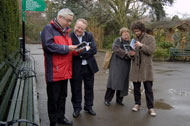|
||||||||||||||||||||||||||||||||||||||||||
|
 An interview with Eugene Byrne and Simon Gurr, the author and illustrator of Darwin: a graphic biography.  How did you manage the collaborative process – one of you writing the text and the other providing the illustrations? Eugene: This is something we get asked about quite a lot. I think most people have the impression that "artists" (and I use the term very loosely in my case, and not at all loosely in Simon's) are big egos and big, individualistic talents who can't work with other people. I think that's one of the biggest misapprehensions that people have about creativity. Sure, painters and poets and novelists usually work alone, but collaboration is actually very normal – essential, even – in a lot of other fields, such as songwriting, filmmaking, scriptwriting and comics. If you and your partner respect one another's abilities and strengths and you're on a similar wavelength, it works. I can't vouch for the quality of the finished product, but all I'm saying is that we have an excellent working relationship. Simon: For me, the collaboration element is one of the biggest attractions of a project like this. The arrival of a new chapter is always eagerly awaited, and the conversations with Eugene are peppered with insights and little known historical facts which leave me a little giddy. Also, he writes great visual gags which I get the credit for! One important part of our process comes later, when I send a completed chapter to Eugene by email. This has led to a number of useful suggestions and corrections to the artwork which I can implement before the whole book is proofread. What were the particular challenges you faced in producing the Darwin biography? Eugene: The main problem with Darwin’s actual life story is that he spent so much time at home working in his study or feeling unwell. His youth, his two universities and of course the voyage of the Beagle are all fun to relate visually, but these were merely the foundations of his actual career. It’s hard to communicate to readers the fact that he spent most of his adult life at home, as a semi-recluse. What’s also tricky is trying to relate to readers of all ages how his theory of natural selection came about, and what it actually meant, and how it works. Evolution is a simple enough idea, but in practice, as biologists are finding all the time, it can be fiendishly complex in its workings. Simon: The popular image of Darwin is that of the bearded old man, but much of our story takes place in his youth or middle age, so it was important to find a visual continuity between the younger likeness and the iconic older man. Fortunately, Darwin comes from a wealthy family so there were portraits of him at different ages which I could refer to. I found the portrait of Charles and his sister as children, by Bristol artist Ellen Sharples, particularly useful. I think George Richmond was a wonderful portrait artist and his 1840 painting of Charles gave me an anchor for the young adult Darwin, before illness and old age changed him. When I visited Down House I saw a display of portraits of Charles arranged in chronological order, which gave me an immediate sense of how his features changed with age. Which episode from Darwin's life did you find the most interesting or inspiring? Eugene: To be honest I personally don’t find Charles Darwin all that “inspiring”. He was a rich kid whose family fortune paid for the Beagle voyage and later gave him sufficient financial security to pursue his studies. In this, you can’t help feeling far more admiration for people like Alfred Russel Wallace and Thomas Huxley, both of whom came from less wealthy backgrounds and both of whom struggled with financial problems to continue in their careers. Huxley, at least, was an intellect every bit as powerful as Darwin’s and arguably he had more moral and intellectual courage. Darwin’s achievement, on the other hand, was in doing a huge amount of work and marshalling a great deal of data for his theory. If Darwin hadn’t had the money; if, say, in a parallel universe he’d not travelled on the Beagle expedition, and had, say, become a clergyman after all, we would still have had a theory of evolution sooner or later anyway. It’s just that it would be someone else’s. By the time he published ‘Origin of Species’ the world was ready for what had previously been a hugely controversial idea, not least because by then so many other naturalists – notably Wallace – were thinking along similar lines. The thing I found most interesting about the history is how politically dangerous an idea natural selection was, because it was seen as a challenge to the authority of the old establishment. The Church, aristocracy, monarchy, the universities were all part of a reactionary oligarchy which was increasingly less successful in holding onto power and privilege after the Napoleonic wars. Questioning the literal truth of Genesis was, until Darwin made it respectable, often the business of radicals – who of course didn’t know the science as well as he did. The other thing that struck me was the way in which creationists nowadays still use precisely the same language and ideas to challenge evolution. Mainstream Christian churches have moved on to accept it and have the intellectual and moral confidence to reconcile belief and science, while fundamentalists can offer no serious scientific challenge to Darwin and so have to resort to fairy tales and shouting. Simon: For me, the Beagle voyage was the most interesting part. Here is a young man who puts up with being horribly seasick every day in order to go out and discover the wider world. I found his bravery and insatiable curiosity hugely inspiring. On top of that, the fascinating character of Captain FitzRoy made this chapter psychologically interesting, and from a scientific angle I had been unaware of the extent of Darwin's geological work until I came to draw this part of the story. What are the advantages – and potential pitfalls – of using a graphic-style format to tell this story? Eugene: Advantages: It's easier to engage readers of all ages. Though we've always thought of this as something aimed at secondary school age kids, I hope a lot of grown ups will look at it as well. You have an unlimited special effects budget. You can do anything you like in a cartoon. You can illustrate all the events you're talking about, if only from imagination. You're not limited by the photos and paintings that are available. It's easier to use humour. By which I mean if something obviously silly is happening in the picture, the reader knows you're trying to be funny. This doesn't always work when you're using just words. You can explain quite complicated facts and ideas graphically. Though usually only after causing yourself an immense amount of tiring brain work. With Darwin of course you have access to a vast supporting cast of flora and fauna, which you can have all sorts of fun with to tell the story, and to try and explain the ideas and the science. With this one we decided to use a group of apes and monkeys making a TV wildlife documentary in and out of the story to move it along and to illustrate various points. We had a lot of fun with them! Pitfalls: You've got to do twice the research. Not only do you need to find out what happened, but you have to find out what it looked like. This means you've got twice the opportunities to get it horribly wrong, though in the case of Darwin and his contemporaries, there’s plenty of photographic material, so it wasn’t as difficult as, say, doing the ancient and medieval sections of The Bristol Story. Simon: For me the combination of words and pictures is far greater than the sum of its parts. It's like the difference between talking to someone on the phone or having a face to face conversation with them. The pictures provide the facial expressions and body language which enhance the spoken words so that you can convey your message more clearly and with fewer words. There are a few practical disadvantages on the production side. It takes longer to draw a pageful of illustrations than it does to write a page of text (generalising dreadfully), similarly it takes longer to design a page of integrated images, speech balloons and captions whilst preserving the narrative flow, than it does to layout a page of text. If you look at it from a Gradgrindian perspective of number of facts per page, then you could squeeze more facts in using unadorned text (preferably in a tiny typeface) but then you would end up with a textbook that few would read and even fewer would remember. What other projects would you like to collaborate on in the future? Eugene: We have talked about a couple of things, including a series of short strips about various historical oddities. It’ll also be interesting to see what the reaction to the Darwin biog is, since it’s our most “comic”-like collaboration to date insofar as I’ve tried very hard to resist the temptation to cram it with words, and instead let the pictures and speech bubbles tell more of the story. Obviously in the meantime we are available at very reasonable rates; ten thousand copies of your own personal graphic biography to give to friends, relatives and passing strangers in the street, could be yours for as little as £30,000 plus VAT. Simon: We want to do a graphic history of the Olympics. It's the only way an arts project will get funded between now and 2012! Joking. I haven't mentioned this to Eugene but I'd really like to do something shorter with him. So far we've done a 28 page online comic, a 96 page graphic biography and a graphic history weighing in at nearly 200 pages. If we carry on like this you'll soon be seeing our unique take on War & Peace. But I do fancy collaborating on something short and pithy, like a graphic version of Eugene's columns for Venue. There's a web comic serial with the unlikely name of Teaching Baby Paranoia by an American artist called Bryant Paul Johnson which I enjoy reading. He'll take three or four panels to recount a fascinating but usually obscure tale from history. A regular weekly or monthly series of short episodes is a format Eugene and I haven't explored together, yet. |
 |
||||||||||||||||||||||||||||||||||||||||
